I'm a casual PC gamer.
Most of the games I play are ones that have been out for a while, mostly due to the fact that I can purchase games very cheaply. If you've browsed my blog, you'll see reviews for a few games, such as Sid Meier's Railroads, Assassin's Creed IV: Black Flag, and Star Wars: Battlefront II (2005).
I play a variety of genres, but my favorite are turn-based strategy games like Civilization. I've ventured out and played many other games though, and today I want to talk about a game that was received poorly at launch, but can still offer hours of entertaining gameplay: SimCity (2013).
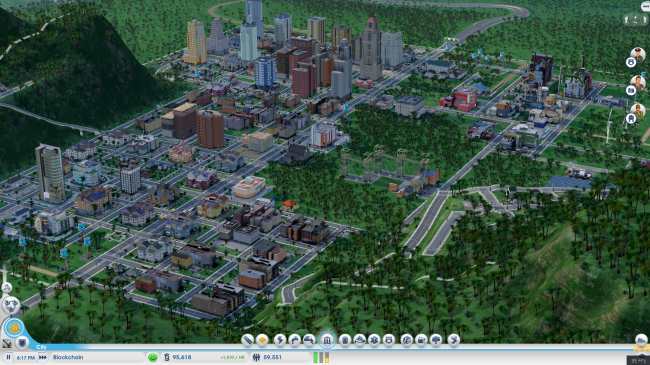

SimCity's Troubled History
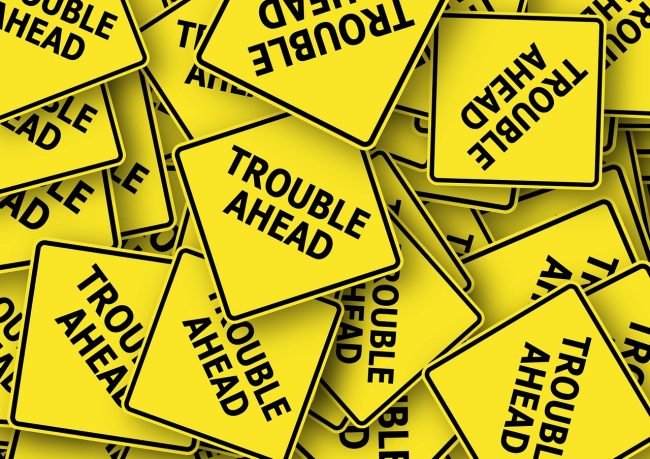
I wasn't into gaming at the time SimCity launched in 2013. EA promised a complete reboot of the beloved SimCity franchise with 3D graphics. I remember hearing about the game on Reddit and several other places across the Web. Since I don't make a habit of buying games right at release, I didn't pay much attention to the hype. However, after the game launched, it continued to be a source of discussion, but not for good reasons.
The game faced many issues at launch. The biggest complaint users had was the fact that EA required an Internet connection to play Single Player mode, a departure from the classic versions of the game. The servers also experienced connectivity issues, and many users experienced other problems with multiplayer and the AI, leading ultimately to many reviews declaring the game "unplayable," and leading Amazon to stop selling the game a week after it launched.
EA would later address and patch most of players' concerns, but a potential huge success was ruined due to several missteps by the developer (this continues to be a common trend with EA. I'm looking at you, Battlefront 2)
So how did I start playing SimCity?
In the summer of 2016, I was visiting a local YMCA thrift store, when I spotted a sealed copy of the game on sale for $1. I decided even if the game was terrible, I'd only be out $1, so why not take a chance?
Needless to say, I'm glad I did. After playing the game for many hours (offline, since EA nixed the online requirement in 2014), I have found the game to be very entertaining, visually pleasing, and a lot of fun, despite some remaining issues.
This opinion will probably still be unpopular with fans of the original SimCity games, but I want to walk through some of the main gameplay features to outline how SimCity can still be a fun experience despite its initial shortcomings.
Getting Started
SimCity is still for sale on Amazon, and you can also purchase the game from EA's Origin game store. Occasionally, they run sales, and I've seen the full game with DLC on sale for as low as $15. I really think it's worth that price, but I'm also glad I got the game for $1.
After launching the game from Origin, you're greeted with the title screen and options to continue the last city you were working on or start a new game.
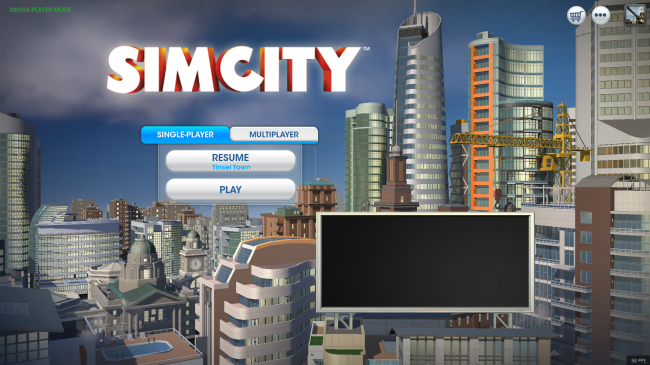
Upon clicking play, you'll have the option to select a region you want to play in. Each region has a specific number of city sites that can be founded, as well as great works project sites. Natural resources vary by region, as well.
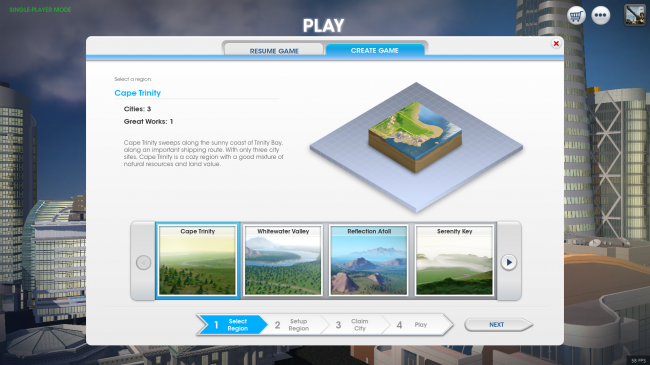
You'll have the option to name your region. I decided on "Steemland," since this region will be dedicated to Steemit! Next, you must select a site to found your first city. Each city spot has resources (coal, ore, oil, water, and wind), and you'll be able to see which sites have the most of each resource when choosing. I selected a balanced city spot.

Upon clicking "Claim," you'll be taken to your blank city site. One other criticism of this game is that the size of the playable area is much smaller than in past games. I do find this to be a concern sometimes, but I'll comment on this later.
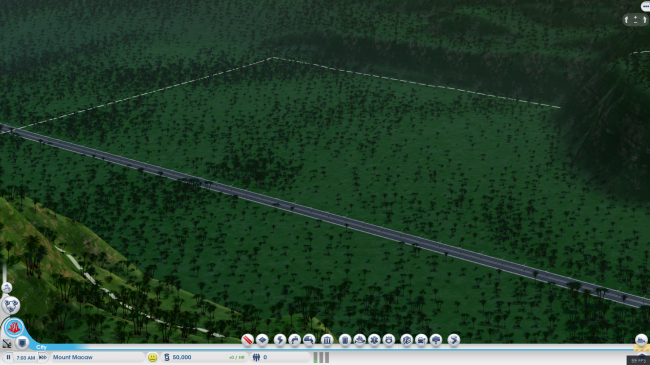
Building Your City
The first thing you must do is connect your city with roads. There are various types of roads, ranging from dirt roads up to avenues with streetcar tracks built in. You only have 50,000 Simoleons (currency in Sims games) to get started, so you'll probably want to choose low density streets to save money for other things. There is a grid system that shows you suggestions for how to put down roads. These are helpful, as they outline the right size for city blocks if you want your housing options to be able to expand later. Here's me placing some roads (I used high density because I forgot it was a new game and I'm used to using high density in my other games):
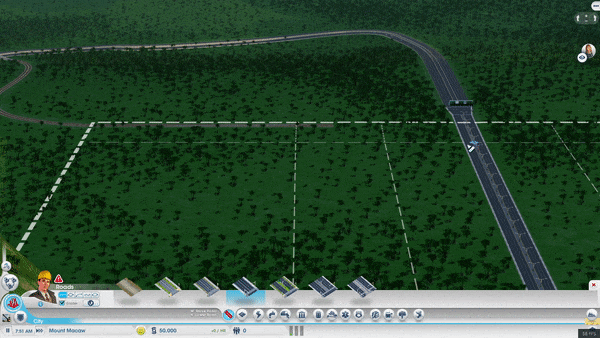
Zoning
The game's main mechanic for establishing where your Sims can live, work, and shop involves zoning districts. You can zone residential (green), commercial (blue), or industrial (yellow). There are several things to consider about where to place your zones since Sims don't like to live downwind of industry, and they want to be close to shops.
Zoning definitely takes practice. There is a small meter that shows the demand for each type of zoning at a given time. Finding the balance between these will be the most challenging aspect of this game, and a mechanic that I think could use some work, but eventually you can find a good balance. I chose to zone my industrial a good distance downwind from my first few residential blocks, and my first commercial block is near the residential blocks:
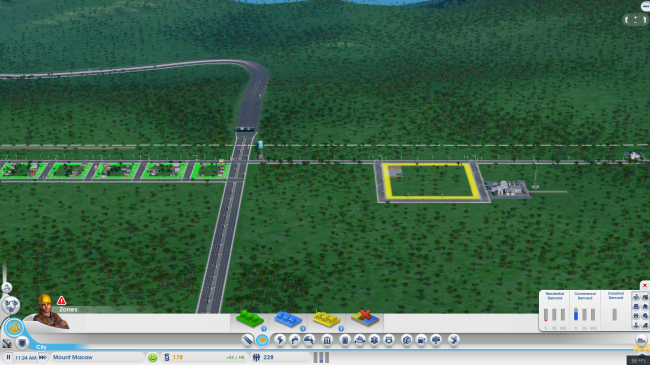
As time passes, Sims will move in to these blocks. They will show up and build houses, shops, and industrial buildings. You can see new houses being built here:
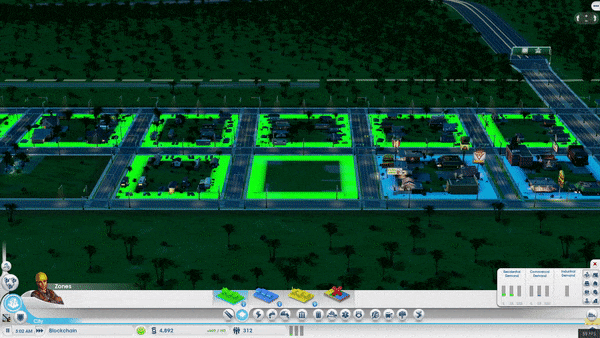
Utilities
Next, you'll need to provide your city with electricity, water, and sewer capabilities. I chose a windy city spot, so I installed a wind power plant. It's inexpensive, but it has a relatively low capacity compared to other options that become available later in the game. I put in several small water towers and a sewer outflow pipe also.
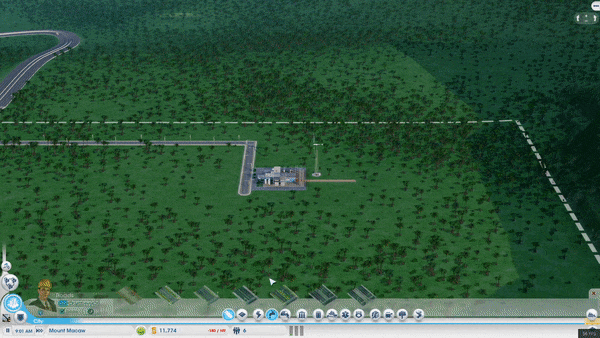
Establishing a Town Hall
After getting the utilities going, you'll be able to place your town hall and name your town. I named this town "Blockchain." You'll notice that the menu bar at the bottom of each of the screenshots I've shared so far shows the various categories you'll need to pay attention to. There's roads, zoning, electricity, water, sewer, town hall, garbage, fire, health, police, education, public transportation, parks, and natural disasters. The toolbar also lets you take a look at your city's finances:
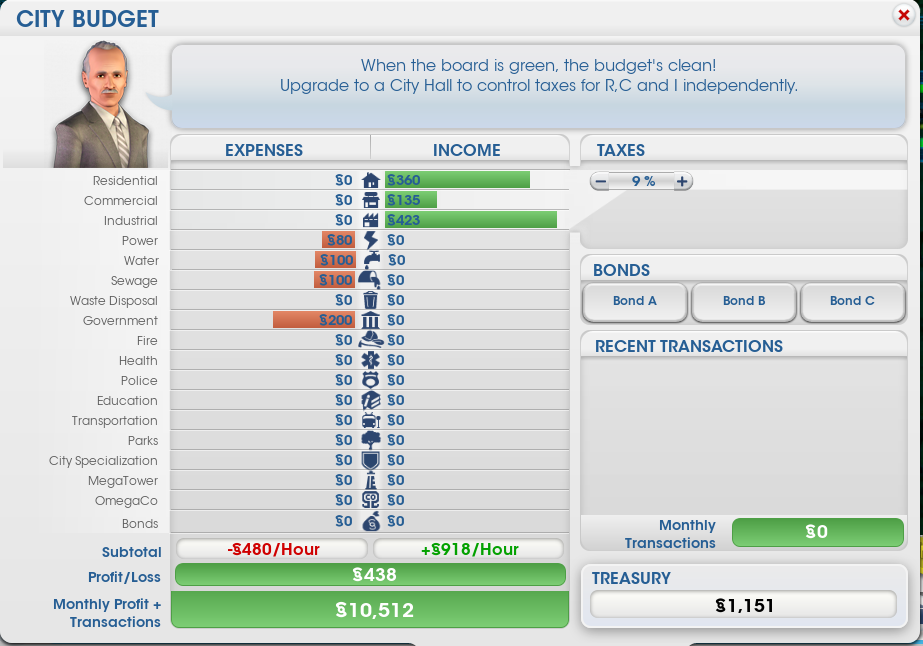
You can also change the tax rate in your city, but if it's too high, your Sims may get angry and move out. You can see how much is being spent on each category, as well as your hourly income. Increasing your hourly income is the best way to make money early in the game, but if you find yourself strapped for cash, you can pass bond measures from this menu to have instant access to cash for an hourly fee.
Keeping Your Sims Happy
Keeping your Sims happy is one of the main goals of the game, and you may do this by increasing their access to health care, fire services, police protection, jobs, shops, and parks. There are also three classes of wealth in SimCity: low, medium, and high. You may change which Sims belong to each wealth class by zoning residential near parks or other government buildings, etc. There's a wealth density map to help you figure out where these zones are:
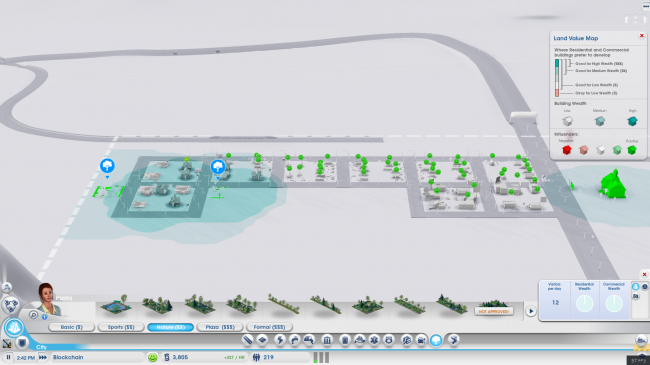
As you add parks and other things that make your Sims happy, more and more of them will want to move to your city, and eventually the residences and shops will expand, allowing more Sims to move to your city.
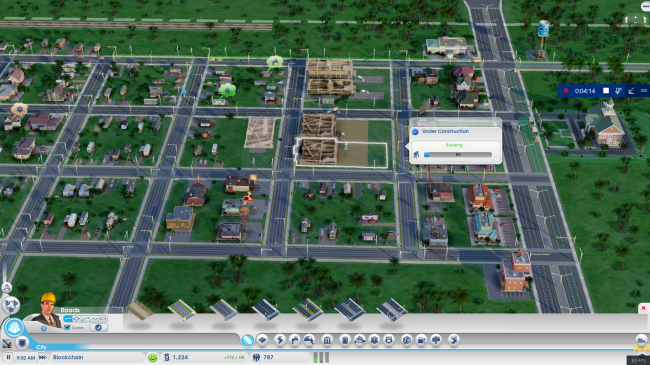
Education
There are many aspects of the game to consider as your city grows. One interesting one is access to education. Eventually, your Sims will start saying that they want schools. If you add schools to your city, your citizens will become educated over time, which can improve the technology level of your industrial zones, which in time will lower their pollution and emissions. There are many overlays that let you monitor the various aspects of the game, such as how educated your Sims are:
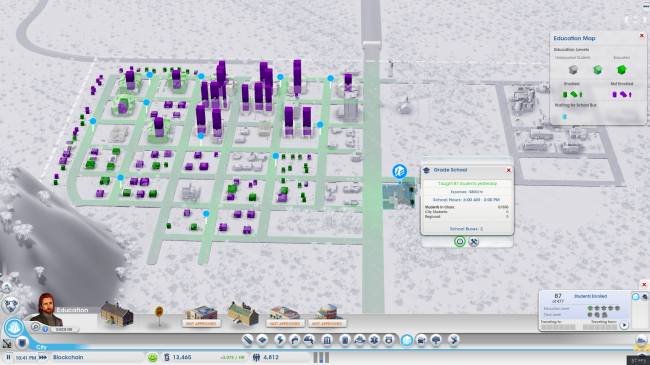
City Specializations
As your city expands, you have the option to specialize your city in mining, drilling, tourism, gambling, or electronics manufacturing. This city happened to be rich in ore, so I decided to plop an ore mine. There are convenient maps that point out where the resources are.
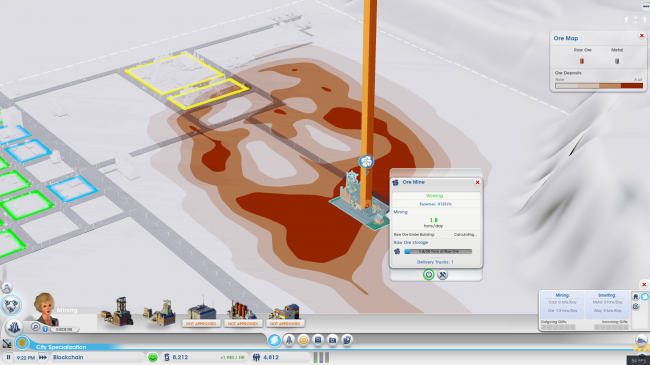
Resources are fun to expand upon, because they become a great source of income for your city. You can sell or import resources on the global market also, which makes acquiring resources your city does not have much easier (for a price, of course).
Expanding Your City
There are so many intricacies of this game that I don't have time to discuss, but once you start getting the hang of things, it becomes easier to expand and build your city larger.
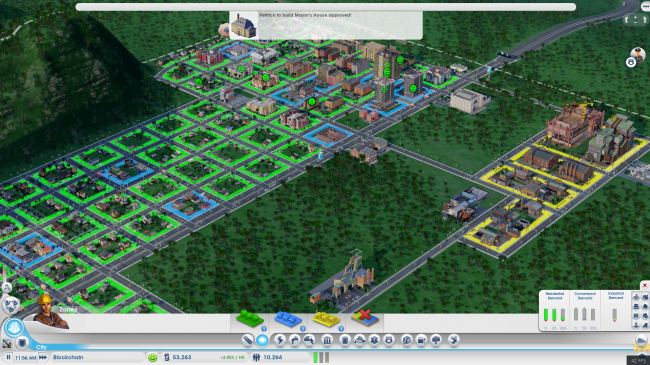
As you can see, I expanded my city even more, ultimately adding schools, more industries, and high and medium wealth residential zones. Keeping the city profitable is a challenge, and so is maintaining a balance between the demand for the various zones, as I discussed earlier.
Establishing Other Cities in the Region
If you haven't had good luck with your first city, never fear, that's what the other city spots in the region are for. Just start another city! Simply zoom out to the region view and select another region to see its natural resources, then click "Claim." There are several advantages to this, including being able to provide fire, water, sewer, health, and police coverage to other cities. This means when you start a new city, you don't have to spend so much money upfront establishing the utilities services, and you can focus more on building a good city layout.
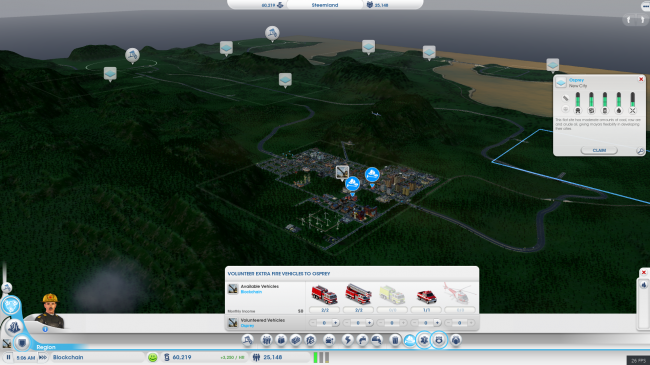
Connecting your cities via public transportation (trains, buses, boats, or planes) allows tourists to travel to and from your cities, as well as workers to commute. This may help with the residential-industrial demand balance. It also allows students from other cities to travel to your city for education. All you have to do is add bus stops!
My Biggest Issue with the Game
My main criticism of the game is that it's possible to keep the residential-industrial demand balanced for a while, but all of the sudden once your factories upgrade to large density, the demand for low income workers skyrockets and there's really no good way to bring it down because you run out of space to expand your residential zones. It seems this issue has been around since the beginning, as it was one of the main criticisms of the game at launch.
To further compound this issue, the area you have to develop your city is much smaller than in past games. The game developer said they did not expand the area because they wanted the graphics to render nicely on all computers. I do wish they would make the area larger, especially because of the demand imbalance after playing a city for a couple of hours. Note the demand meters in this screenshot:
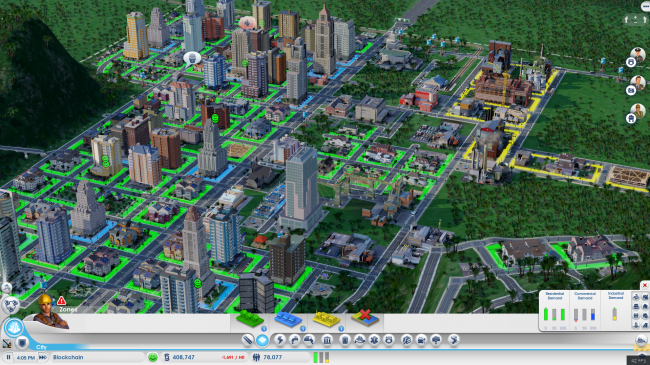
It is still possible to have a happy and profitable city despite the imbalance issue with the AI, so if you get to this point and the game keeps yelling at you about a high demand for workers, ignore it and just make sure that your factories and specialization buildings have workers. You'll be just fine.
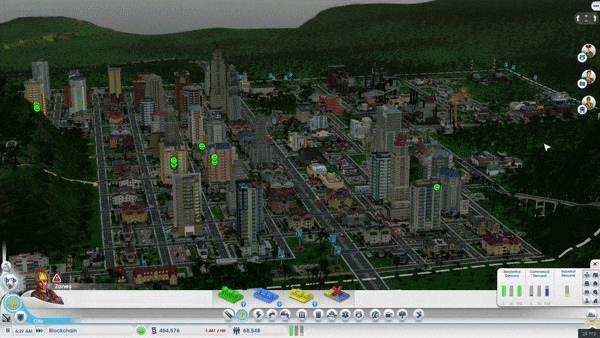
Final Thoughts
Despite its shortcomings, SimCity (2013) remains a fun game if you enjoy simulation-style gaming. I don't think I would recommend paying full price for the game, since it does still have unavoidable issues, but I believe EA has patched most of the aggregious issues that plagued the game when it launched.
I've spent hours playing this game, and it can be fun having many cities in one region. If you see SimCity on sale on Origin or Amazon, or if you happen upon a copy in a thrift store, give it a shot.
I've not tried multiplayer, but I'm sure that could be much fun also. I'd love to hear your thoughts on SimCity, especially if you've spent time playing the game. I'm always interested in new things to try.
I plan to blog again about the region of Steemland once I have several cities founded and humming along nicely. I hope I'll have a sprawling region soon, so if you have suggestions for names for my cities, please let me know in the comments!
As always, thanks for stopping by!



